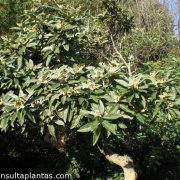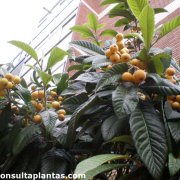Care of the tree Eriobotrya japonica or Loquat |
|
The genus Eriobotrya, family Rosaceae, comprises 60 species of trees and shrubs native to the Far East. Some species are: Eriobotrya japonica, Eriobotrya deflexa, Eriobotrya grandiflora, Eriobotrya buisanensis. Common names: Loquat, Japanese plum, Japanese medlar, Chinese plum. This species is native to China. They are evergreen trees with a rounded crown that reach 5 meters (16.4 feet) in height. The large, oval, leathery leaves are dark green on the upper surface and light green on the underside. They produce bouquets of scented cream or white flowers. The edible fruit (medlar) is orange and egg-shaped. Loquat is used as fruit tree and as shade tree in small gardens. Eriobotrya japonica can be grown in full sun and semi-shade exposures. The humidity must be high. It resists light and occasional frosts. The soil can be a garden substrate with 15% organic matter and 15% coarse sand. Planting is done in early autumn. Water regularly waiting for the soil to dry; Japanese plum resists drought quite well. Fertilize in autumn with manure and from mid-autumn to late winter use every 15 days with mineral fertilizer. Chinese plum does not need pruning. Eriobotrya japonica is an easy to grow tree and resistant to the usual pests and diseases. Loquat propagates by seeds or by layering. |
Images of the tree Eriobotrya japonica or Loquat |
Find plants
Eriobotrya japonica or Loquat | Care and Growing
© 2025 FavThemes



